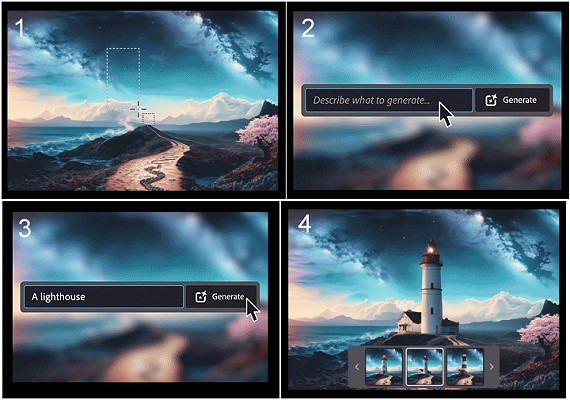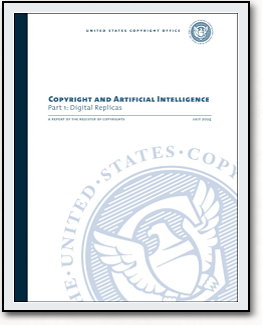 | ||||
|
|
ESSAYS - 2024 ESSAY In 2003, two brief pieces appeared on the site to fill what was then a new section. Over the years a theme developed, and now the essays in most cases deal with some aspect of technological change, usually with a consumer bent. In past summers, anywhere from one to four essays have been posted during the summer. In the summer of 2023 there was one essay, and it has been added to the Essay Archives. The Essay Archives contain links to all essays which have appeared on the site since its inception. Below is the 2024 summer essay.
PAINTING PICTURES WITH WORDS: GENERATIVE ARTIFICIAL INTELLIGENCE (AI), INTELLECTUAL PROPERTY AND A BRIEF LOOK AT THE ROAD AHEAD The background imagery and many of the digital images appearing on the site this summer were generated by artificial intelligence. Though millions of people have been using AI text-to-image generators since they have become available, particularly for the last couple of years, they may still remain a mystery to those unfamiliar with their use. This essay will offer a general view and explanation of text-to-image generators, discuss intellectual property (IP) issues associated with AI-generated digital images and offer a brief look at steps being taken to ensure the authenticity of the digital media which has become so prevalent in our world. If at any point the viewer would like to understand certain AI-related terms, an AI glossary can be found by clicking here. As with past essays, various links and and embedded videos are included in this article. The viewer is welcome to read only the text of the essay or learn more about the subject by exploring the links or watching the embedded videos which are included. Please know that AI is rapidly-evolving field, and information included in this essay is what was available as of September 2024.
"Theatre D'Opera Spatial," Midjourney-generated image by Jason M. Allen. In the summer of 2022, Jason M. Allen entered the image above, titled "Theatre D'Opera Spatial," in the Colorado State Fair. The image was generated by the text-to-image AI program Midjourney, and it was entered into the fair's digital arts category, digital arts being defined by the fair's rules as an "artistic practice that uses digital technology as part of the creative or presentation process." (n1) The image was awarded the first place prize in the category. Controversy about the image and discussion about the nature of art arose after Mr. Allen revealed online that he had created the image in Midjourney. The fair's judges later said that though they "were unaware that Allen had used AI to create his piece, . . . even if they had known, they still would've given him first place . . . based on the story Theatre D'Opera Spatial tells, as well as the spirit it invokes." (n2) In September of 2022, Allen filed an application with the U.S. Copyright Office to register the two-dimensional artwork. According to U.S. Copyright Office documents, "while Mr. Allen did not disclose in his application that the [image] was created using an AI system, the Office was aware of the Work because it had garnered national attention." (n3) The Copyright examiner(s) requested additional information from Allen about the work and his process of arriving at the final image. In his response, Allen stated that he "input numerous revisions and text prompts at least 624 times [in Midjourney] to arrive at the initial version of the image. . . [and] after Midjourney produced the initial version of the Work, he used Adobe Photoshop to remove flaws and create new visual content and used Gigapixel AI to 'upscale' the image, increasing its resolution and size." (n4). The Copyright Office denied registration of the work, and after appeals and a review board process over the next year, the initial decision was affirmed. Though the Copyright Office agreed that the visual edits made with Adobe Photoshop contained a "sufficient amount of original authorship to be registered, . . . however, , , , the features generated by Midjourney and Gigapixel AI must be excluded as non-human authorship. . . Because Mr. Allen sought to register the entire work and refused to disclaim [exclude] the portions attributable to AI, the Office could not register the claim." (n5)
The subjects of AI-generated content, whether text, images or other types of output, their treatment within the intellectual property system, and the verification of their authenticity and provenance (origin and history), have rapidly become matters of significant public debate and interest. The text below will provide an introduction to, and examples of, text-to-image generators, discuss U.S. Copyright Office policy and practice regarding AI-produced content, and outline actions being taken to verify and authenticate various types of media which may have been produced or altered by artificial intelligence. INPUT: TEXT, OUTPUT: IMAGES - AI TEXT-TO-IMAGE GENERATORS Text-to-image generators use the input of words to generate the output of an image. The words input can be as simple or specific/complex as desired. As discussed throughout this site over the summer, most of the images generated for the site came from the input of the words "a perfect world," as well as other words modified by "perfect," such as "a perfect tree," "a perfect smile," etc. Text-to-image generators, ChatGPT and similar systems fall under the category of "generative AI." In an article for MIT News, author Adam Zewe defined generative AI as "a machine-learning model that is trained to create new data, rather than making a prediction about a specific dataset. A generative AI system is one that learns to generate more objects that look like the data it was trained on." (n6, click here to read the full article explaining generative AI.) It is probably important to remind the reader here that there is no one single AI system. Each content-generating system, whether for image or text generation, is owned and or operated by a company or organization, is guided by proprietary algorithms, is trained on different but massive datasets, and (in most cases) offers different options to the end user. At this time, all text-to-image generators must be used online, because the generative function requires massive computing power housed at AI data centers. Though probably the subject for a separate essay, the amount of power required to operate these AI data centers is growing exponentially. Though forecasts vary, some project that "data centers could account for 25% of U.S. power consumption by 2030 based on surging demand for AI chatbots and AI training." (n7) Getting Started with a Text-to-Image Generator There are a number of text-to-image generators available, and three in particular will be discussed below. Plans and access vary from free and free trials to different levels of subscriptions. Since these are constantly changing, it is recommended that the user check for the most current information for each image-generating system. For most systems, the words input to generate an image are referred to as prompts, and most generators allow for a certain number of credits, tokens or some other measure of the number of images able to be created in a given time period. Once word prompts have been input, a fairly common output generated is four square images based on those prompts. Some systems also allow for changes to the size of the images which are generated. Microsoft Bing Image Creator login screen image. Microsoft Bing Image Creator. The Microsoft Bing Image Creator can be accessed at www.bing.com/create or www.bing.com/images/create, and the log-in screen is shown in the picture above. This image generator is powered by Open AI's DALL-E 3, and it is free to use with a Microsoft account (if you use Hotmail, for example, you can log in using the same email address and password). If you click on the words "Learn More," found just under the bright pink "Join and Create" box, you can find out a bit more about the system and suggestions for structuring the prompts. Also, if you are logging in on a desktop computer, once you are logged in you will see a wide variety square images like the ones see above. Holding a cursor over the image will reveal the prompts entered to generate it. Imagine AI Art Generator. The Imagine AI Art Generator can be accessed at www.imagine.art, and it is a product from the company Vyro (www.vyro.ai). Vyro describes Imagine AI as "an innovative art generator accessible on the web, Android and iOS platforms, designed to provide individuals with easy access to the latest generative art technologies." Though there is some free use of Imagine AI permitted, there is no free trial, and full use of most premium features requires the purchase of a weekly or monthly plan. Plan costs can be viewed on the Imagine.Art website. In addition to text-to-image generation, Imagine AI offers applications including AI Video, Ideate (turning doodles to art), and Image Remix (altering exiting images), plus "mini-apps" Realtime Generation, Creative Upscaler and Character Consistency. Different sizes for generated images (other than square) also can be specified. As stated in various locations on this site, most of the images used this summer were generated by the Imagine AI Art Generator. Midjourney. The above image shows a login screen for Midjourmey found at https://discord.com/invite/midjourney. You have to create a Discord account in order to use Midjourney, and according to the information on the screen shown above, there are more than 20 million Midjourney members. At www.midjourney.com Midjourney is described as "an independent research lab exploring new mediums of thought and expanding the imaginative powers of the human species." You also can sign up and log in from the Midjourney.com site. Beginning users might want a bit of direction in using Midjourney, and a good place to start is at https://docs.midjourney.com. On that page you can find a Quick Start Guide, links to "Getting Started" and "Using Discord," and access to articles on subscription plans, terms of service,prompts and style reference. The creators of Midjourney note at https://docs.midjourney.com/ docs/stealth that Midjourney is an open-by-default community, and all image generations are visible at Midjourney.com. However, subscribers to the two highest plan levels can use Stealth mode which prevents your images from being visible to others on the Midjourney website. Read more on the web page listed. On this site, you can find images created in Midjourney by Guest Photographer Ann Elliott Cutting on the All Cities By City concert page (click the link to view the images in a new window). She says of the image generator that "Midjourney has consistently stood out to me for its refined style. I also use Stable Diffusion, but I find that Midjourney's ability to incorporate style references is particularly helpful. I've been using Midjourney since Version 2, and now, with the release of Version 6.1, it's been about a year of exploring its evolution." She also says she is "fascinated by the unique qualities of these early AI creations," and she can see a future in which photography may "evolve into a hybrid process - combining real elements like people, clothing and products with AI-driven enhancements." Information on a couple of other AI-related programs may be of use to those interested in AI-generated content. Most text-to-image AI-generated images are relatively small/low resolution. Those wishing to enlarge the images will likely need a program for "upscaling" the images. In the text above regarding "Theatre D'Opera Spatial," its creator referenced the program Gigapixel AI as the means he used to upscale the image, increasing its resolution and size. Information on Gigapixel can be found at www.topazlabs.com/gigapixel. Earlier this month, an email message under the subject heading "September Community Newsletter: Generative AI" went out to Adobe Creative Cloud customers from David Wadhwani, President of Digital Media at Adobe. In the letter addressing Adobe's approach to AI, he said the following: "'Adobe has always looked for innovative ways to implement new technologies that help creators realize their vision. For the past few years, we've been very focused on delivering innovation that we believe will make the communities we serve more productive. Much of this innovation involves harnessing AI breakthroughs to reduce the tedious and repetitive work that often makes up a significant portion of the creative process. This work, and generative AI advances in general, have caused some in the creative industry to ask some fundamental questions about the definition of creativity, about ways to protect creator rights and even about the future of creative industries. . . The process of adding a lighthouse to a starting image in Adobe Photoshop using the new Generative Fill function is depicted below, and the Content Authenticity Initiave mentioned will be discussed a little later in the text. First, however, the U.S. Copyright Office's treatment of AI content and the Office's current actions regarding AI-generated materials will be outlined in greater depth. Adding a lighthouse with Adobe Photoshop Generative Fill: 1. begin with base image, 2. open Generative Fill function, 3. enter word prompt in box and click "generate," and 4. select lighthouse from generated images. AI-GENERATED MATERIALS AND U.S. COPYRIGHT OFFICE POLICY In addition to the U.S. Copyright Office case listed above for the image "Theatre D'Opera Spatial," another case involving the attempted copyright of Midjourney-generated AI images has received considerable attention. This second case involved the copyright for a comic book titled "Zarya of the Dawn." Initially, based on a copyright application for the work which neither disclosed AI-generated content nor disclaimed any part of the work generated by Midjourney, a copyright was granted. However, as outlined in correspondence between the U.S. Copyright Office and the attorneys for the comic book's author, Kristina Kashtanova, "Shortly after registering the Work, the Office became aware of statements on social media attributed to Ms. Kashtanova that she had created the comic book using Midjorney artificial intelligence. Because the application had not disclosed the use of artificial intelligence, the Office determined that the application was incorrect, or at a minimum, substantively incomplete." (n9) After additional review and correspondence, the original certificate was cancelled and a new, more limited registration was granted. That new certificate of registration covered "the original authorship that Ms. Kashtanova contributed to the work, namely the 'text' and the 'selection, coordination and arrangement of artwork created by artificial intelligence and text created by the author', . . ." but specifically excluded "artwork generated by artificial intelligence." (n10) The correspondence from the U.S. Copyright Office concluded by saying "the Office will add the following annotation to the new certificate: 'Reason for Reregistration: VAU001480196 cancelled pursuant to 37 CFR 201.7 (c)(4) for failure to exclude non-human authorship.'" (n11)
Two other significant points were contained with in the "Zarya" correpondence: the human authorship requiement for the granting of a copyright, and the description of how the office views AI-generated content, in this particular case, content created by Midjourney. "Rather than a tool that Ms. Kashtanova controlled and guided to reach her desired image, Midjourney generates images in an unpredictable way. Accordingly, Midjourney users are not the 'authors' for copyright purposes of the images the technology generates. As the Supreme Court has explained, the 'author' of a copyrighted work is the one 'who has actually formed the picture,' the one who acts as 'the inventive or master mind.' Burrow-Giles, 111 U.S. at 61. A person who provides text prompts to Midjourney does not 'actually form' the generated images and is not the 'master mind' behind them. Instead, as explained above, Midjourney begins the image generation process with a field of visual 'noise,' which is refined based on tokens created from user prompts that relate to Midjourney’s training database. The information in the prompt may 'influence' generated image, but prompt text does not dictate a specific result . . . Because of the significant distance between what a user may direct Midjourney to create and the visual material Midjourney actually produces, Midjourney users lack sufficient control over generated images to be treated as the master mind' behind them. In both the Zarya and Theater D'Opera Spatial cases, the Copyright Office would allow claims of authorship for provable creative edits and refinements to AI-generated images made with Photoshop or similar programs, as long as the AI-generated portions were disclaimed [excluded]. What remains to be seen in the future is how Photoshop and similar refinements will be treated now that AI capabilities are being added to the programs. In the lighthouse image included above, would the base image be eligible for copyright but not lighthouse added with the AI Generative Fill? A question like that is one of many being generated (no pun intended) with the rapid pace of change in the field of Aritificial Intelligence. The Copyright Office is attempting to adjust to those developments and has taken steps to examine copyright law and policy issues related to AI. In 2023, the Office outlined its policy and entered into the Federal Register a document titled "Copyright Registration Guidance: Works Containing Material Generated by Artifiicial Intelligence." The document was published in the Federal Register on March 16, 2023, 16190 Federal Register, Vol. 88, No. 51, Rules and Regulations, 37 CFR Part 202, and it can be downloaded at www.copyright.gov/ ai/ai_policy_guidance.pdf. The conclusion of that report also stated that "The Office continues to monitor new factual and legal developments involving AI and copyright and may issue additional guidance in the future related to registration or the other copyright issues implicated by this technology." (n14) In the Digital Replicas report, ditigal replicas are defined as "a video, image or audio recording that has been digitally created or manipulated to realistically or falsely depict an individual. A digital replica may be authorized or unathorized and can be produced by any type of digital technology, not just AI. (n16) The report notes that "while digital replicas depicting well-known individuals often attract the most attention, anyone can be vulnerable," (n17) and identifies three categories beyond the just the creative sector into which harms from unauthorized digital replicas largely fall: the production of sexually explicit deepfake imagery, the means of perpetrating fraudulent activity with alarming ease and sophistication, and the undermining of our political system and news reporting by making misinformation impossible to discern. (n18) The report also details current and proposed legislation to protect against the harmful impact of digital replicas and makes recommemdations on needed legislation, but concludes that there is an urgent need for new protection and legislation at the federal level. The July 2024 report can be downloaded now, and future portions of the report will be able to be downloaded later, at the U.S. Copyright Office's Copyright and Artificial Intelligence web page at www.copyright.gov/ai. BEYOND THE COPYRIGHT OFFICE: VERIFYING AUTHENTICITY AND PROVENANCE IN DIGITAL MEDIA While the term provenance may be familiar to most people in the art world, it may not be a term with which others are familiar. The word "provenance" refers to the place of origin or earliest known history of something. In the art world, it refers to the record of ownership of a work of art or antique and is usually used to determine authenticity or quality. In an age of easily modified digital media and deepfakes, organizations beyond the U.S. Copyright Office have recognized the need for some type of mechanism by which to verify the origin and authenticity of digital media. Two organizations working toward that end are the Content Authenticity Initiative (CAI, https://contentauthenticity.org) and the Coalition for Content Provenance and Authenticity (C2PA, https://c2pa.org). As explained on the Content Authenticity Initiative website at https://contentauthenticity.org/how-it-works, the CAI is a cross-industry coalition of . . . major media and technology companies. It was founded by Adobe in 2019, and Adobe continues to lead it. The CAI develops open-source tools for verifiably recording the provenance of any digital media, including content made with generative AI. The coalition’s mission is to support broad adoption, making content authenticity and transparency scalable and accessible. The C2PA is a formal coalition dedicated to addressing the prevalence of misleading information online through the development of technical standards for certifying the source and history (or provenance) of media content. It’s a mutually governed standards development organization (SDO) under the structure of the Linux Foundation’s Joint Development Foundation, formed through an alliance between Adobe, Arm, Intel, Microsoft, and Truepic. The C2PA unifies the efforts of the Adobe-led CAI, which focuses on systems to provide context and history for digital media, and Project Origin, a Microsoft and BBC-led initiative that tackles disinformation in the digital news ecosystem. The difference between the two is that the CAI drives feature explorations, creates open-source tools, and fosters community around a movement toward greater content authenticity online, while the C2PA complements these efforts by providing the end-to-end open technical standards for creators, editors, publishers, media platforms, and consumers. (n19) A brief video introducing the CAI and its mission from the organization's 2023 symposium is included below.
The over 3000 members of the CAI community are listed on the CAI website and include companies such as Adobe, Leica Camera AG, Nikon and Canon, media and publishing organizations like the Associated Press, the BBC and Reuters, and techology leaders like Microsoft, Nvidia and Qualcomm. (See https://contentauthenticity.org/our-members) The secure, tamper-evident, end-to-end system for digital content provenance, which the organization refers to as Content Credentials, is gradually being incorporated into a wide variety of digital media and products. The following examples are drawn from the Creation, Editing and Generative AI, and Publishing sections of the CAI "How it Works" pages. For example:
Leica has released the M11-P camera, the world's first camera with Content Credentials built in, a new way for photojournalists and creatives to . . . bring authenticity to their work at the point of creation. Nikon is bringing Content Credentials to future camera models, starting with its Z9 series. Qualcomm is bringing provenance technology to smartphones with Content Credentials embedded at the chip level, supporting photo authenticity for consumers and their devices, ensuring authenticity of photos and videos across smartphones. Adobe is integrating Content Credentials across its apps and services. Adobe Photoshop, Lightroom and Adobe Camera Raw support the technology, and every image generated by Adobe Firefly uses Content Credentials to indicate the use of AI. Microsoft Microsoft has brought Content Credentials fo all AI-generated images created with Bing Image Creator. The invisible digital watermark feature adheres to C2PA specifications and confirms the time and date of original creation. BBC News announced its implementation of Content Credentials, which are now embedded in its images. This will help people verify content provenance and authenticity while also helping counter possible disinformation when content is shared beyond official BBC channels. How do Content Credentials work? Probably the easiest way to understand is to watch the 8+ minute video included below. The video, titled "DEMO: C2PA Content Provenance Specification in Action," is from Ravnur Inc. It shows the C2PA Content Provenance spec 1.0 in action.
In a very short time, generative AI and the products of generative AI have brought with them an entirely new "world" of issues for individuals, companies/organizations and governments to consider. As AI continues to grow as a technology with the potential to bring momentous change to humans' lives and livelihoods, there undoubtedly will be questions about how best to deal with those changes. What has been presented here is just a brief view of measures which industries and governments have begun to take in response to some of the most immediate challenges posed by AI. They represent only a small, targeted set of actions in a specific area of interest, but hopefully have provided useful perspective on the ways in which some of AI's new challenges are beginning to be met. Thank you for visiting the Essays section on www.dorothyswebsite.org, and please come back again in 2025! FOOTNOTES
- The following are the footnotes indicated in the text in parentheses
with the letter "n" and a number. If you click the asterisk at the end of
the footnote, it will take you back to the paragraph where you left
off. n1 - Kuta, Sarah, "Art Made with Artificial Intelligence Wins at State Fair," Smithsonian Magazine, September 6, 2022, available at https://www.smithsonianmag.com/smart-news/artificial-intelligence-art-wins-colorado-state-fair-180980703.(*) n3 - Copyright Review Board, U.S. Copyright Office, letter to Tamara Pester, Esq. RE: Second Request for Reconsideration for Refusal to Register Theatre D'Opera Spatial (SR #1-11743923581; Correspondence ID: 1-5T5320R), September 5, 2023, p. 2. (*) n6 - Zewe, Adam, "Explained: Generative AI," MIT News, November 9, 2023, available at https://news.mit.edu/2023/explained-generative-ai-1109. (*) n7 - Kindig, Beth, "AI Power Consumption: Rapidly Becoming Mission-Critical," Forbes (online), June 20, 2024, available at https://www.forbes.com/sites/bethkindig/2024/06/20/ai-power-consumption-rapidly-becoming-mission-critical. (*) n8 - Wadhwani, David, "September Community Newsletter: Generative AI," email message to Adobe Creative Cloiud Customers, September 11, 2024. (*) n9 - U.S. Copyright Office, letter to Van Lindberg, Taylor English Duma LLP, from Robert J. Kasunic, Associate Register of Copyrights and Director of the Office of Registration Policy and Practice, RE: Zarya of the Dawn (Registration #VAu001480196) citing previous correspondence ID 1-5GB561K, February 21, 2023, pp. 2 - 3. (*) n14 - U.S. Copyright Office, Copyright Registration Guidance: Works Containing Material Generated by Artificial Intelligence, 16190 Federal Register, Vol, 88, No. 51, Rules And Regulations, 37 CFR Part 202, March 16, 2023, p. 6. (*) n15 - U.S. Copyright Office, Artificial Intelligence Study web page, viewed September 2024 at http://www.copyright.gov/policy/artificial-intelligence. (*) n16 - U.S. Copyright Office, Copyright and Artificial Intelligence Part 1: Digital Replicas, A Report of the Register of Copyrights, July 2024, p. 2. (*) n19 - Content Authenticity Initiative FAQs, viewed online September 2024 at https://contentauthenticity.org/how-it-works (*) LINKS
INCLUDED IN ESSAY - The following are links included in the essay.
Glossary of Artificial Intelligence -
https://en.wikipedia.org/wiki/glossary_of_artificial_intelligence Explained: Generative AI - https://news.mit.edu/2023/explained-generative-ai-1109 Microsoft Bing Image Creator - www.bing.com/create or www.bing.com/images/create Imagine AI Art Generator - www.imagine.art Vyro (parent company of the Imagine AI Art Generator) - www.vyro.ai Midjourney links - https://discord.com/invite/midjourney, www.midjourney.com, https://docs.midjourney.com and https://docs.midjourney.com/docs/stealth All Cities By City concert page, www.dorothyswebsite.org - www.dorothyswebsite.org/2024all_citiesCity.html Gigapixel AI Upscaling Program - www.topzalabs.com/gigapixel Adobe Firefly AI - www.adobe.com/products/firefly.html U.S. Copyright Office. Copyright Registration Guidance: Works Containing Material Generated by Artificial Intelligence - www.copyright.gov/ ai/ai_policy_guidance.pdf U.S. Copyright Office. Copyright and Artificial Intelligence web page - www.copyright.gov/ai Content Authenticity Initiative (CAI) - https://contentauthenticity.org Coalition for Content Provenance and Authenticity (C2PA) - https://c2pa.org Content Authenticity Initiative (CAI) FAQs - https://contentauthenticity.org/how-it-works Video link: CAI 2023 Symposium Highlights - www.youtube.com/watch?v=Ow0Jv5yHQmI Video link: DEMO: C2PA Content Provenance Specification in Action - www.youtube.com/watch?v=hA0ZjqakEF8 BIBLIOGRAPHY - The following is the Bibliography for the September 2024 essay. Copyright Review Board, U.S. Copyright Office, letter to Tamara Pester, Esq. RE: Second Request for Reconsideration for Refusal to Register Theatre D'Opera Spatial (SR #1-11743923581; Correspondence ID: 1-5T5320R), September 5, 2023, available at https://www.copyright.gov/rulings-filings/review-board/docs/Theatre-Dopera-Spatial.pdf. Viewed September 2024. International Energy Agency, Electricity 2024: Analysis and Forecasts to 2026, January 2024 (and May 2024), available at http://www.iea.org or https://iea.blob.core.windows.net/assets/18f3ed24-4b26-4c83-a3d2-8a1be51c8cc8/Electricity2024-Analysisandforecaststo2026.pdf. Viewed September 2024. Kindig, Beth, "AI Power Consumption: Rapidly Becoming Mission-Critical," Forbes (online), June 20, 2024, available at https://www.forbes.com/sites/bethkindig/2024/06/20/ai-power-consumption-rapidly-becoming-mission-critical. Viewed September 2024. Kuta, Sarah, "Art Made with Artificial Intelligence Wins at State Fair," Smithsonian Magazine, September 6, 2022, available at https://www.smithsonianmag.com/smart-news/artificial-intelligence-art-wins-colorado-state-fair-180980703. Viewed September 2024. Maruccia, Alfonso, "AI Data Centers Could Soon Become a Scourge for the Energy Industry," Techspot.com, April 10, 2024, available at https://www.techspot.com/news/102574-ai-chatbots-have-insatiable-unsustainable-thirst-power.html. Viewed September 2024. U.S. Copyright Office, Copyright and Artificial Intelligence Part 1: Digital Replicas, A Report of the Register of Copyrights, Washington D.C.: July 2024. U.S. Copyright Office, Copyright Registration Guidance: Works Containing Material Generated by Artificial Intelligence, 16190 Federal Register, Vol, 88, No. 51, Rules And Regulations, 37 CFR Part 202, March 16, 2023, available at https://www.copyright.gov/ ai/ai_policy_guidance.pdf Viewed September 2024. U.S. Copyright Office, letter to Van Lindberg, Taylor English Duma LLP, from Robert J. Kasunic, Associate Register of Copyrights and Director of the Office of Registration Policy and Practice, RE: Zarya of the Dawn (Registration #VAu001480196) citing previous correspondence ID 1-5GB561K, February 21, 2023, available at https://www.copyright.gov/docs/zarya-of-the-dawn.pdf. Viewed September 2024. Zewe, Adam, "Explained: Generative AI," MIT News, November 9, 2023, available at https://news.mit.edu/2023/explained-generative-ai-1109. Viewed September 2024.
"Like" www.dorothyswebsite.org on FACEBOOK! Home | Essays | Poetry | Free Concerts | Website Book Page | Arts/Events | About the Site | News |
|||
 | ||||
|
www.dorothyswebsite.org © 2003 - 2025 (except AI images) Dorothy A. Birsic. All rights reserved. Comments? Questions? Send an e-mail to: information@dorothyswebsite.org | ||||



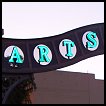




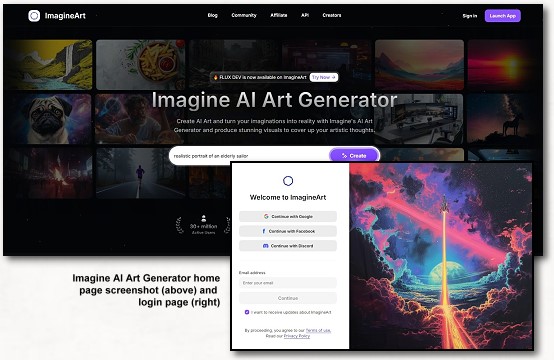
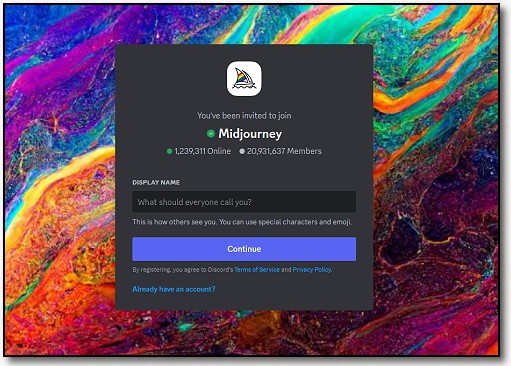
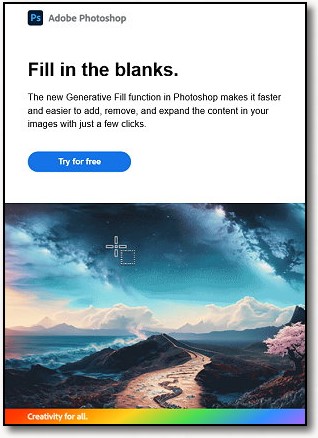 Those who use Adobe programs like Photoshop or Illustrator or who are members of the Adobe Creative Cloud are likely to have received emails over the last couple of months advertising the new AI capabilities to be incorporated into Adobe products. The image here on the left is from an email advertisement for the new Generative Fill function in Photoshop. An example of how the Generative Fill function in Photoshop will work (derived from the gif image pictured in the ad) is included below. As with other AI systems, most generative AI functions at this time will need to be used online due to the computer power necessary to back those functions. Adobe has named their AI Firefly. Details about how Firefly AI will be incorporated into various Adobe products can be found at
Those who use Adobe programs like Photoshop or Illustrator or who are members of the Adobe Creative Cloud are likely to have received emails over the last couple of months advertising the new AI capabilities to be incorporated into Adobe products. The image here on the left is from an email advertisement for the new Generative Fill function in Photoshop. An example of how the Generative Fill function in Photoshop will work (derived from the gif image pictured in the ad) is included below. As with other AI systems, most generative AI functions at this time will need to be used online due to the computer power necessary to back those functions. Adobe has named their AI Firefly. Details about how Firefly AI will be incorporated into various Adobe products can be found at 